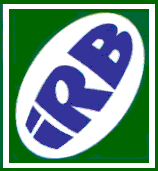 |
||
 |
||

Introduction Outcome Goals: Attack - Defense - Performance Goals: Attack - Defense - Frequent Errors - Team Selection - Conclusion
In General Play players must identify and perform their roles as play develops. There are few specific positions as exist in 15-a-side. Players must recognise the situation and react to complement the behaviour of team-mates. Of the specific roles, the role of sweeper in defence is one example. This player's role is explained above as are the roles of the thrower, jumper and support player in a lineout and the front row in the scrum.
Halfback / Scrum-halfThe role of the halfback or scrum-half is a specialised role. in defence, this player stands behind the scrum so that the player can move to the side in which play is developing. By committing to one side, usually the side of the put-in, the other side is left free in the absence of flankers. This may vary if the scrum is able to exert greater pressure. in these circumstances the scrum-half will take advantage of being able to stand just behind the centre line on the right hand side of the scrum, initially. Once the ball has been put-in the ball becomes the offside line for this player so long as the player does not move away from the scrum. Problems created by the screw and the kick-through, makes this a better position to exploit this advantage. In attack, the speed with which the ball comes out of the scrum means that the scrum-half must be very quick and agile. The player must be alert to the positioning of the opposing scrum-half. If this player stands on the right side on the throw-in a gap in the defence will exist on the left which should be exploited immediately. If the defending scrum-half stands behind the scrum, then there will be time to recover the ball to attack. As the defending scrum-half is some way from the ball the scrum half may have time to go forward. This will enable forwards breaking from the scrum to enter play more easily as they will have to move back only a few metres to be on- side.
HookerEven though there may be few scrums in Sevens matches, the specialist skills of hooking and throwing in at the lineout may be worth considering to ensure accuracy at these. The player must, however, be talented at the other aspects of the Sevens game.
Team selectionIn Sevens all players must be skilled in a wide range of individual skills so they can react to any situation. Each skill must be able to be performed at pace, as Sevens is a game of rapid changes of speed, from slow manouvering to an explosion of speed once there has been a breach in the defense. Players must be fast and powerful with high levels of anaerobic stamina so that they recover rapidly. In order to select a Sevens team the Game Plan and Pattern of Play that the team is to play to must be known. This will allow for fine-tuning, however, there are both general roles and position responsibilities that are common to most teams.
General CharacteristicsAs opposed to 15-a-side rugby, position specification is not as important. Sevens selection places a premium on speed of running, reactions and expertise at individual skills. Of these, the most important are passing, running and tackling. There is no substitute for pace, speed of hand and strong devastating tackling. There is no room for poor tacklers, as this single weakness can lose a match. In addition to this, players should have excellent peripheral vision and spatial awareness. This combined with the judgement of when to go into contact and when to maintain a pattern, to enable a long-term advantage to be gained, makes for the best Sevens player. The best all-round athlete makes the best Sevens player. Of course, size, without compromising the other characteristics is a bonus. Loose forwards or backs can adapt to the forward roles. They probably have to, because tight forwards do not normally have the most important general skills. Of the specialists you probably require a 5crum-half who can clear loose ball to space. Each squad should have at least two play-makers. These players must have peripheral vision, judgement and decision-making abilities. More than any other player, they must be closely involved in the development of the Game Plan, Patterns of Play and Tactics. This involvement should involve their participation in decisions made by the coaches and the captain on these issues. They should therefore be a regular member of the team of long experience and/or someone who has an innate feel for Sevens. These skills can be fine-tuned by decision-making practice drills. The obvious players for this role are the link players in is's, ie, the scrum-half/ halfback and the outhalf/stand-off/ ist five-eighth as they will be used to this role in 15's. However, they must also have the other basic attributes of a Sevens player. if they do not, they may be isolated and targeted by opponents. Their individual involvement in the match could be so great that they will not be able to perform the play-maker role. on attack the play-maker should set up the play and let others carry it out. By doing this the player is able to think ahead to the next option. It is essential that a team has one or two players who are able to drop-kick both at restarts and to convert the tries that are scored. The normal format for Sevens is a tournament. Teams must be fit enough to last the whole tournament. To achieve this the team may wish to adopt tactics that conserve energy once a win has been achieved in pool matches. Tournament rules may base seedings for the post pool play, on tries being scored, but this should not prevent a team from adopting sensible policies regarding use of kick options, the use of substitutions and the extent to which they are prepared to race to score or defend, once a clear break has been made.
|
Copyright 1999-2025
